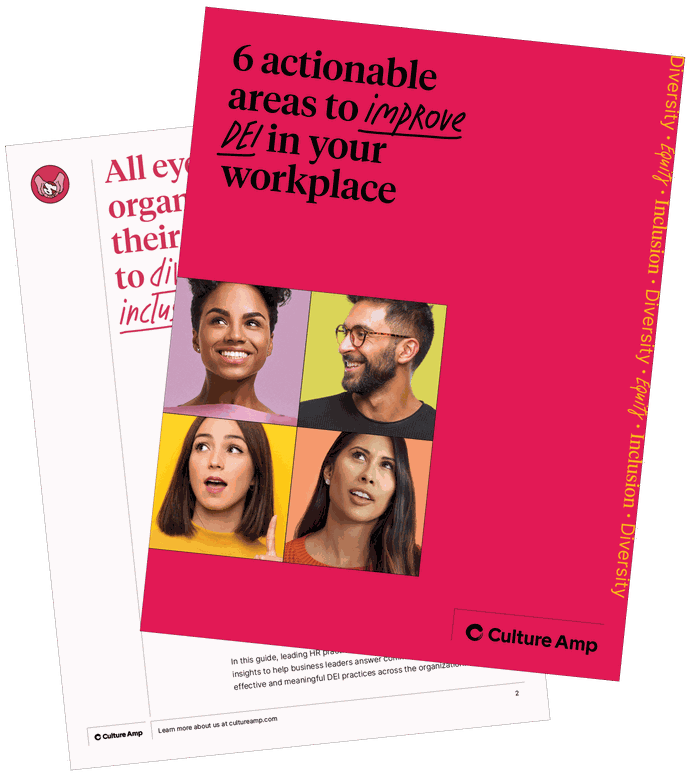4 ways to support and amplify your Latine employees

What is the most meaningful way to celebrate Latine Heritage Month? There’s no simple answer, but one effective approach any company can take is to listen to and amplify the voices of Latine employees.
In the same way that every employees’ needs, hopes, and pain points are unique, so too are the areas your organization most needs to improve upon. Rather than make assumptions about what your Latine employees find most meaningful, try asking them instead. As long as you actually take action on their feedback, your employees will likely be happy to provide honest insights that can guide not just Latine Heritage Month celebrations, but your overall diversity, equity, and inclusion strategy.
As discussed in the first blog, Latine identity is inherently complex. Capturing all the nuances of Latine identity is impossible, but making the effort to recognize these differences and build them into DEI initiatives is crucial for building a workplace where everyone can thrive. In this second part of our Latine Heritage Month series, we asked four of our Campers to share what they think organizations and individuals can do to effectively support their peers and employees from the Latine community. Here’s what they had to say.
Educate your employees, especially if you’re a global company
Liba Boksh, Senior Outbound Sales Strategist (UK)
“Latin Americans residing in the UK often call themselves the "Invisibles,” as a reflection of the lack of representation they have in communities and the fact that there is no formal ethnic minority status for Latin Americans. Therefore, someone who identifies as Latine in the UK would probably identify as ‘White or other.’
There was a petition in the UK to Include Latine/Hispanic as an ethnic group in the 2021 census, which unfortunately failed to get the 10,000 signatures it needed to be considered. The following is the information on the petition:
‘I want the UK Government to acknowledge the huge population of Latine/Latinx/Hispanics here in the UK by adding a box allowing us to specifically designate this as our ethnic origin in the census form. We are not white, black, Asian, and certainly not ‘other.
The UK population is extremely diverse. Census forms having a box for most races/ethnicities allows recognition, understanding, and in turn opportunity.
Latine/Latinx/Hispanics have a huge population here in the UK, however, we always seem to struggle with our identity here, we aren't acknowledged but simply put into the ‘other’ box. This is not a true reflection of the population. In the USA the Census Bureau lets people identify as Latine/Latinx/Hispanic, we want the same here in the UK.’
Organizations in the UK probably have employees who identify as Latine who may not know where they fit due to the UK's limited list of ethnic groups. So it's important to educate your employees – especially if you are a global company – and learn from your US-Based Latine counterparts.”
Build understanding by amplifying Latine voices and experiences
Rafael Athayde Mello, Data Engineer (AUS)
“Latine, Latinx, or Hispanic isn’t really a thing in Australia because it’s such a small minority. In fact, Latin American Australians make up less than 1% of the entire population. So for me, it’s easy to feel invisible and that my history and family don’t matter because few people see it or hear about it.
I personally identify as Brazilian, and I wish I had more opportunities to really share my culture because I love Brazilian music, Brazilian food, and Brazilian festivals. And yes, there are sometimes really reductive stereotypes, but I think the key is building that understanding.
So, I think organizations should give counsel to folks on how to approach people with different backgrounds. I personally love talking about Brazil, and I love it when people ask me about it. But there’s a perception that it’s rude or not something we talk about in the workplace. But for myself, I think it’s great as long as people approach it in a curious way and are genuinely interested in people’s traditions, history, and what it’s like to grow up in South America.”
Disaggregate your data and perception of Latine folks
Vivian Woo, Lead People Science Analyst (US)
“Depending on the country you come from and/or the country your family comes from, your experience in the United States can be very different. Where you settle can be highly influenced by your identity because certain metropolitan areas may feature certain Latine groups more prominently than others.
It doesn’t make sense to treat all Latine people the same because there are huge differences, dialectically and culturally. This makes sense because we all come from different countries of origin. There are nuances, which is why you shouldn’t make assumptions about people speaking Spanish, for example, just because they ‘look’ Latine.
As another example, the Asian diaspora landed in South and Central America. Many people don’t think of these folks as Latine, but there’s a pretty notable Asian population in various South and Central American countries. There’s a pretty large group of people of Japanese descent in Brazil. And across Latin America, there are many Chinatowns that have been established by Chinese immigrants over the years. As with all immigration stories, old and new cultures combine into something new, which often gets overlooked in the mainstream.
So, disaggregate these groups. There are differences. And it’s one of those things that people outside of the culture may not recognize, but there are absolutely differences. So we need to celebrate the fact that in some ways we are the same and in some ways we are different.”
Take action at both the individual and organizational level
Kenneth Matos, Director of People Science (US)
“At its core, diversity, equity, and inclusion isn’t just for any particular month.
For organizations, it’s an ongoing examination of systems and processes. For example, you should review your hiring pipeline and identify which efforts get you the greatest diversity of quality candidates. Invest in those methods first. If you don’t have any high diversity recruitment pipelines, build group-specific recruitment efforts that position you as an attractive employer to demographics that may be less familiar with your brand or opportunities. For example, advertising jobs on sites catering to Latine employees in your field could demonstrate your commitment to more diverse hiring and win you some great employees.
For individuals, the best thing you can do is ask yourself: Am I a fair-weather ally? Tasty food, music, and dance are all fun to learn about, but are you also willing to listen to our challenges? Usually when underrepresented groups speak to majorities about their experiences of bias the majority group member tries to explain away what happened: ‘I’m sure they didn’t mean it that way.’ Regardless of intent, those comments allow the majority to continue to believe in a just world and avoid conflict while telling the underrepresented group members to be quiet. Instead of trying to rationalize the events, just offer a simple ‘I’m sorry that happened to you. How can I help?’ This approach opens the door to helping your colleague or friend process the experience or asks for support.”
Taking your commitment to DEI beyond Latine Heritage Month
Celebrating and supporting your Latine/Latinx/Hispanic employees shouldn’t begin and end with Latine Heritage Month. If you’re truly invested in helping to improve the everyday experiences of Latine employees, then you must take your commitment to improve DEI beyond just this one month.
To start, encourage your organization to hold a diversity, equity, and inclusion survey. The employee experience isn’t equal, and thoughtful surveys can provide the data and insights necessary to make a meaningful impact on inclusion, belonging, and equity in your organization.
As an individual, one of the most important first steps you can take is to educate yourself and others. Take care to avoid any resources that try to capture the entirety of “Latine” into a single article that skims over the texture of different communities’ histories and experiences. Every community is different, so choose resources focused on specific national and ethnic groups (e.g., Brazil, Chile, Mexican-Americans in the United States). This will improve not just your one-on-one interactions with folks from the Latine community, but also provide the rich context necessary to build programs that acknowledge the vast diversity of Latine experiences.
Diversity, equity, and inclusion is a journey taken in small steps, but we all have a part to play in moving the needle on DEI. By creating systems and processes that protect our most vulnerable employees, we can help build a more equitable, fair, and inclusive workplace for every employee.







